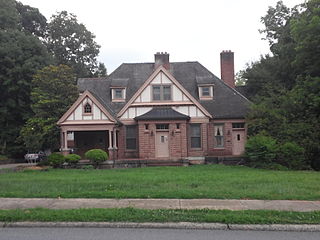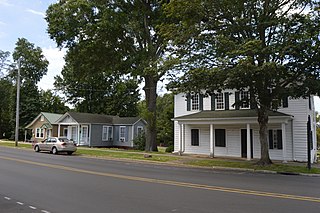
Lincoln County is a county located in the U.S. state of North Carolina. As of the 2020 census, the population was 86,810. Its county seat is Lincolnton. Lincoln County is included in the Charlotte-Concord-Gastonia, NC-SC Metropolitan Statistical Area.

Lincoln County is a county located in the east central portion of the U.S. state of Georgia. As of the 2010 census, the population was 7,996. The county seat is Lincolnton. The county was created on February 20, 1796.

Lincolnton is a city in Lincoln County, North Carolina, United States, within the Charlotte metropolitan area. The population was 10,486 at the 2010 census. Lincolnton is northwest of Charlotte, on the South Fork of the Catawba River. The city is the county seat of Lincoln County, and is the only legally incorporated municipality wholly within the county.
Iron Station is an unincorporated community and census-designated place (CDP) in Lincoln County, North Carolina, United States. A primarily industrial town, Iron Station's population was 755 as of the 2010 census. It also serves as a bedroom community for the larger cities of Charlotte, Hickory, and Lincolnton.
Lincoln County Courthouse may refer to:

Emmanuel Lutheran Church is a historic Lutheran church building located at 216 S. Aspen Street in Lincolnton, Lincoln County, North Carolina. It was built in 1919, and is a rectangular Late Gothic Revival style brick church with a four-stage central tower with a conical steeple. It features pale beige terra cotta, cast stone, granite, and poured cement detailing; lancet arched door and window openings; and stepped buttresses.

The Lincoln Cultural Center, also known as the former First Baptist Church of Lincolnton is a historic church location at 403 E. Main Street in Lincolnton, Lincoln County, North Carolina. The building was designed by architect James M. McMichael in a Classical Revival style with a tetrastyle two-story portico and a spherical dome. Its plans were approved in 1919; construction was completed in 1922. The building was acquired by Lincoln County and renovated as the Lincoln Cultural Center and opened for public use in September 1991.

First Presbyterian Church is a historic Presbyterian church building located at 114 W. Main Street in Lincolnton, Lincoln County, North Carolina. It was built in 1917, and is a rectangular Late Gothic Revival style brick church with projecting corner towers. It has a front gable slate roof and features shallow, cement-capped buttresses, and lancet-arch windows. The interior is a modified Akron Plan with a theater-style sanctuary and adjoining space for extra seating or Sunday school.

First United Methodist Church is a historic United Methodist church building located at 201 E. Main Street in Lincolnton, Lincoln County, North Carolina. It was built in three stages in 1919–1920, 1936, and 1956–1957. The oldest section is a two-story Classical Revival style brick church with a two-story portico and dome-covered sanctuary.

St. Luke's Episcopal Church and Cemetery is a historic Episcopal church complex, cemetery, and national historic district located at 303-321 N. Cedar Street, 322 E. McBee Street in Lincolnton, Lincoln County, North Carolina. The complex includes the church, parish hall, and rectory. The church was built in 1885–1886, and is a Late Gothic Revival style frame structure with a brick veneer added in 1922–1923. The tower is believed to date to 1859. The parish hall was built in 1907, and is a one-story, rectangular frame building. The rectory was built in 1911–1912, and is a two-story, "T"-form Colonial Revival style dwelling with a pebbledash finish. The cemetery includes approximately 300 gravestones, with the earliest dating to 1854.

The Emanuel United Church of Christ, also known as Emanuel Reformed Church, is a historic United Church of Christ church building located at 329 E. Main St. in Lincolnton, Lincoln County, North Carolina. It was designed by Henry E. Bonitz and built in 1913. It is a rectangular Late Gothic Revival style red-orange brick church with a four-stage corner tower. It features cast cement detailing, lancet arched windows, and buttresses with cement caps.

Shadow Lawn is a historic home located at Lincolnton, Lincoln County, North Carolina. It was built in 1826, and is a two-story, five-bay by two-bay, Federal-style brick mansion. It has a gable roof, is set on a full basement, and features three exterior end chimneys. It was the home of Congressman Charles R. Jonas (1904–1988), who purchased the property in 1935.

Lincoln County Courthouse is a historic courthouse building located at Lincolnton, Lincoln County, North Carolina. It was designed by Raleigh architect James A. Salter and built in 1921. It is three-story, ashlar stone, Classical Revival style building. It has a taller central section flanked by flat roofed wings, matching pedimented hexastyle Doric order porticoes on the front and rear of the center section, and a Doric frieze along its sides.

Pleasant Retreat Academy, also known as The Confederate Memorial Hall, is a historic building located at 129 East Pine Street, Lincolnton, North Carolina.

Methodist Church Cemetery is a historic Methodist cemetery and national historic district located at Lincolnton, Lincoln County, North Carolina. It was established about 1828, and contains the marked graves of some 275 members of the Methodist church, and/or citizens of Lincolnton. The gravestones include notable examples of 19th and early-20th century funerary art. The property was also the site of Lincolnton's Methodist churches and religious worship from about 1822 until 1920.

Old White Church Cemetery, also known as Emanuel Church Cemetery, is a historic cemetery and national historic district located at Lincolnton, Lincoln County, North Carolina. It was established in 1788, and contains the marked graves of some 265 citizens of Lincolnton, with an even larger number of unmarked graves. The oldest marked grave dates to 1801. The gravestones include notable examples of 19th and early-20th century funerary art. It is the oldest burying ground in the town of Lincolnton.

Lincolnton Commercial Historic District is a national historic district located at Lincolnton, Lincoln County, North Carolina. It encompasses 62 contributing buildings and 2 contributing objects in the central business district of Lincolnton. It includes a variety of commercial, institutional, and industrial buildings dating between about 1900 and 1955. Located in the district are the separately listed Classical Revival style Lincoln County Courthouse and First United Methodist Church. Other notable buildings include the Frank Beal House, Karl L. Lawing House, Reinhardt Building, Carolina First National Bank, Central Candy and Cigar Company, Jonas Building, Wampum Department Stores, Rhodes and Corriher Company building, and Coca-Cola Bottling Company building.

South Aspen Street Historic District is a national historic district in Lincolnton, Lincoln County, North Carolina. It encompasses 46 contributing buildings and one contributing structure in a predominantly residential section of town. It includes examples of Greek Revival and Queen Anne style architecture dating between about 1852 and 1950. Buildings include the Wallace H. Alexander House (1852), Banett-Hoyle House (1852), the former Lincoln/Gordon Crowell Memorial Hospital, the former Lincolnton High School, John M. Rhodes House, the David P. Rhodes House, the C. William Rhodes House, and the John D. Abernathy House.

West Main Street Historic District is a national historic district located at Lincolnton, Lincoln County, North Carolina. It encompasses 18 contributing buildings in a predominantly residential section of Lincolnton. It includes notable examples of Federal, Greek Revival and Colonial Revival style architecture dating between about 1819 and 1941. Located in the district is the separately listed Shadow Lawn. Other notable buildings include the Michal-Butt-Brown-Pressly House, William H. Michal House, Rouser-Hildebrand-Burgin House, Robert Steve Reinhardt House, and Charles Hoover, Jr., House.

Eureka Manufacturing Company Cotton Mill, also known as Tait Yarn Company and Lincoln Bonded Warehouse Company, is a historic cotton mill located at Lincolnton, Lincoln County, North Carolina. It was built between 1907 and 1910, and is a two-story, brick factory building with a three-story stair tower. Adjacent to the factory is a two-story brick office building built between 1902 and 1906. The buildings housed the Eureka Manufacturing Company from 1906 to 1937, and Tait Yarn Company from 1949 to 1966. Lincoln Bonded Warehouse occupied the buildings into the late-1990s. The buildings are owned by the Lincoln County Historical Association.





















